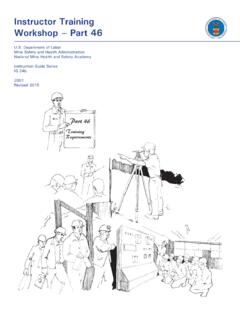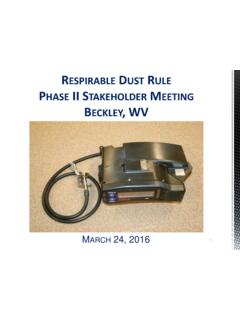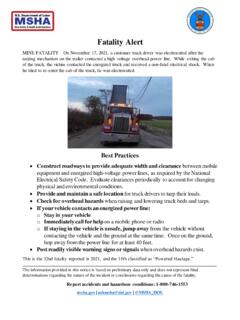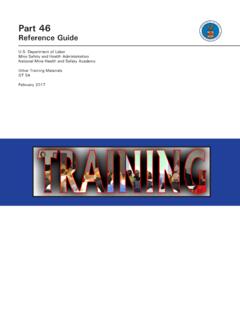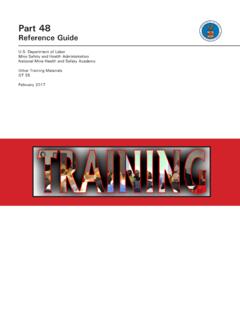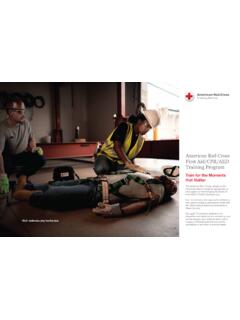Transcription of 2021 Courses for MSHA and the Mining Industry
1 Courses for MSHA and the Mining Industry Department of Labor Mine Safety and Health Administration National Mine Health and Safety Academy FY 2021. Dedicated to the Health and Safety of the Nation's Miners Courses can be scheduled for on-site training or can be held at the National Mine Academy. When scheduling a course, the length of the training can be modified to suit individual needs. Visit the Mine Safety and Health Administration at Welcome Welcome to the 2021 edition of Courses for MSHA and the Mining Industry . Our Nation's mines produce more material than ever before. Sophisticated machinery and equipment allow miners to work in areas that are often complex and dangerous.
2 Mining technology is always changing and every mine is unique. The Mining Industry is constantly in need of new miners. Most of these miners are inexperienced and must be trained prior to employment. This is why (1) Mine Safety and Health Inspections, (2) Technical and Engineering Assistance, and (3) Education and Training are important elements in ensuring a safe workplace. These are the three elements of MSHA's triangle of success. Up-to-date and practical health and safety training is vital since Mining occurs in a hazardous, ever-changing environment where there is little room for error. The National Mine Health and Safety Academy, in Beaver, West Virginia, is the world's largest institution devoted to health and safety in Mining .
3 It is a central training facility for Federal mine safety and health inspectors, mine safety professionals, other government agencies, the Mining Industry , and labor. Most of the Academy's Courses are open to participants from all throughout the Mining community. Classes are taught by Academy faculty and associate instructors and specialists from the Mining Industry , trade associations, colleges and universities, manufacturers, and other government agencies. Whatever your interest in mine health and safety, you will find useful and practical training at the National Mine Health and Safety Academy. Contents Page 1.
4 The Academy's Purpose and 1. Academy 2. Academic 3. Academic 5. Student 7. Fees and 9. Travel to the Route Map to the 12. Training 13. Accident Prevention 15. Annual Retraining for Impoundment 16. Atmospheric Monitoring System (AMS) with Emphasis on Fire 17. Blasting 18. MSHA Electrical Specialists 19. Coal Mine Dust Personal Sampling Unit (CMDPSU). Initial Maintenance and Calibration 20. Coal Mine Dust Personal Sampling Unit (CMDPSU) Initial Sampling 21. Coal Mine Dust Personal Sampling Unit (CMDPSU). Maintenance and Calibration Recertification 22. Coal Mine Dust Personal Sampling Unit (CMDPSU). Sampling Recertification 23.
5 Continuous Personal Dust Monitor (CPDM) . Initial Maintenance and Calibration 24. Continuous Personal Dust Monitor (CPDM) . Maintenance and Calibration Recertification 25. Continuous Personal Dust Monitor (CPDM) . Initial Sampling 26. i Page Continuous Personal Dust Monitor (CPDM) Sampling Recertification 27. Electrical 28. Electrical Safety for Coal 29. Electrical Safety for MNM 30. First Aid/CPR/AED (American Red Cross).. 31. Ground Control 32. Haulage (Surface) 33. Haulage (Surface) 34. Hazard Communication (HAZCOM).. 35. MSHA Dam Safety Specialist Training 36. Industrial 37. Industrial Hygiene: Sampling for Respirable Silica.
6 Dust and 38. instructor Training Workshop (Part 48).. 39. Introduction to 40. Law, Regulation, Policy, Citation/Order Writing, Inspection 41 Microsoft Excel 2016 42. Microsoft Excel 2016 43. Microsoft Excel 2016 44. Microsoft PowerPoint 2016 45. Microsoft Word 2016 46. Microsoft Word 2016 47. Microsoft Word 2016 48. Mine Accident Investigation and Report 49. Mine Accident Investigation 50. Mine Construction, Maintenance, and Repairs 51. Mine Emergency Unit Joint 52. Mine Emergency Unit Joint 53. ii Page Mine Explosion 54. Mine Hoist and Elevator Inspection Program 55. Mine Rescue 56. Mine Rescue VISIO Mapping and Map Scoring.
7 57. Mine 58. MSHA Accident Investigation 59. Noise Hazards, Regulation, and 60. Off Road Tire 61. Qualification for Impoundment 62. Roof Control 63. Roof Control Specialists 64. Slope and Shaft Sinking 65. Special Investigators 66. Special Investigators 67. Surface Facilities and Coal 68. Tailings Dam and Waste Pile Inspection - 69. TRAM/National Mine Instructors 70. Underground Diesel Equipment/Ventilation .. 71. Underground Ventilation for MNM 72. Ventilation Specialists 73. Workplace 74. MSHA 75. Enrollment 77. Suggestion Form for New 79. Other Available 81. iii iv History Protecting those who work in our Nation's mines requires an awareness and understanding of the conditions that endanger their health and safety.
8 This problem was recognized more than 140 years ago when a proposal for a Federal Mining bureau was submitted to Congress. It was not until nearly five decades later that a series of deadly mine explosions led to passage of the Organic Act of 1910. That Act created the Bureau of Mines. Laws passed over the next 60 years enlarged the scope of legislation aimed at reducing Mining hazards. The Federal Coal Mine Health and Safety Act of 1969 contained provisions for the training of Federal mine safety and health inspectors, as well as establishing education and training for states, mine operators, and miners.
9 The Federal Mine Health and Safety Act of 1977. broadened these provisions to include metal and nonmetal Mining . The National Mine Health and Safety Academy supports the requirements of the 1977 Act, and the newly enacted Mine Improvement and New Emergency Response Act of 2006. The Academy's Purpose and Goal The purpose of the Academy is to design, develop, and conduct instructional programs that will assist in government, Industry , and labor efforts to reduce injuries, illnesses, and fatalities in the mineral industries. All of our programs, seminars, and Courses are prepared with one idea in mind to improve health and safety conditions in mines through education and training.
10 This is our goal. Our success will be measured by the extent to which mine accidents and unhealthful conditions are reduced in future years. 1. Academy Map 2. Academic Programs MSHA Training All newly hired MSHA mine safety and health inspectors receive entry-level training. This training covers technical aspects of mine inspection and additional topics such as effective communications and professionalism. Entry-level inspectors receive six modules of instruction (24. weeks total) at the Academy in conjunction with required web- based training and on-the-job training (OJT) sessions in the field. Journeyman retraining presents up-to-date technical and regulatory information to journeyman mine safety and health inspectors to help them ensure that the Mining community is served most effectively.
